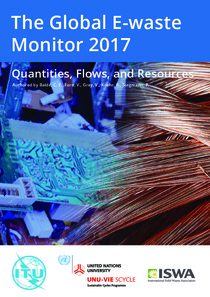The global e-waste monitor 2017: quantities, flows and resources
"...The report seeks to increase global awareness and draw attention to the growing world issue of e-waste, which includes discarded products with a battery or plug including mobile phones, laptops, televisions, refrigerators and electrical toys. The assessment shows that in 2016, 44.7 million...
| Main Authors: | , , , , |
|---|---|
| Institution: | ETUI-European Trade Union Institute |
| Format: | TEXT |
| Language: | English |
| Published: |
Tokyo
2017
UNU |
| Subjects: | |
| Online Access: | https://www.labourline.org/KENTIKA-19303765124911219479-The-global-e-waste-monitor-201.htm |
| Summary: | "...The report seeks to increase global awareness and draw attention to the growing world issue of e-waste, which includes discarded products with a battery or plug including mobile phones, laptops, televisions, refrigerators and electrical toys.
The assessment shows that in 2016, 44.7 million metric tonnes of e-waste were generated, up 3.3 million metric tonnes (8 per cent) from 2014. In 2016, only about 20 per cent – or 8.9 million metric tonnes – of all e-waste was recycled. Experts foresee a further 17 per cent increase — to 52.2 million metric tonnes of e-waste by 2021.
The assessment also highlights the significant and growing risk to the environment and human health due to increasing levels of e-waste and its improper and unsafe treatment and disposal through burning or in dumpsites.
The assessment also notes positive news – that there is now a growing number of countries adopting e-waste legislation. Currently 66 per cent of the world population, living in 67 countries, is covered by national e-waste management laws, a significant increase from 44 per cent in 2014. National e-waste policies and legislation play an important role as they set standards, guidelines and obligations to govern the actions of stakeholders who are associated with e-waste.
"Environmental protection is one of the three pillars of sustainable development and ITU is at the forefront of advocating for the safe disposal of waste generated by information and communication technologies. E-waste management is an urgent issue in today's digitally dependent world, where use of electronic devices is ever increasing – and is included in ITU's Connect 2020 Agenda targets," said ITU Secretary-General Houlin Zhao. "The Global E-waste Monitor serves as a valuable resource for governments developing their necessary management strategies, standards and policies to reduce the adverse health and environmental effects of e-waste – and will help ITU members to realize this Connect 2020 target."
"With 53.6 per cent of global households now having Internet access, information and communications technologies are improving peoples' lives and empowering them to enhance their social and economic well-being," said Brahima Sanou, Director of the ITU Telecommunication Development Bureau. "The Global E-Waste Monitor represents an important step in identifying solutions for e-waste. Better e-waste data will help evaluate developments over time, set and assess targets, and contribute to developing national policies. National e-waste policies will help minimize e-waste production, prevent illegal dumping and improper treatment of e-waste, promote recycling, and create jobs in the refurbishment and recycling sector. ..." |
|---|---|
| Physical Description: | 109 p. Digital |

